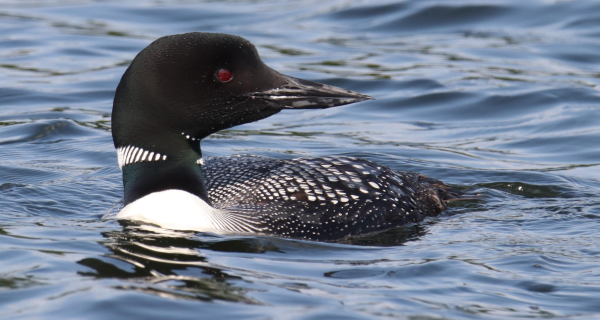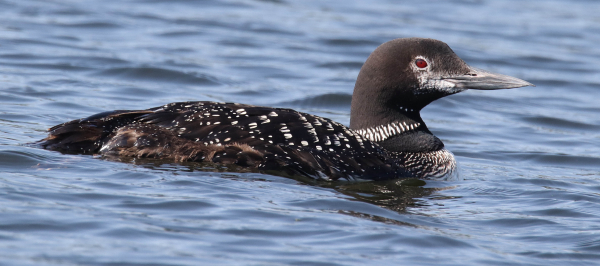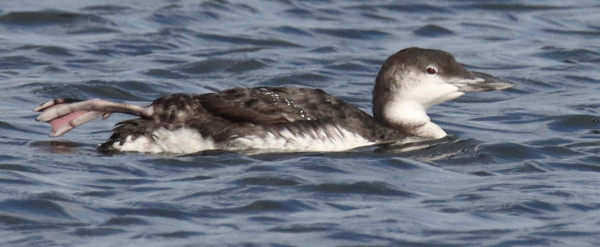While chronicling the growth and development of the young Common Loon over the course of the summer, as fall approached, I knew I could also try to document the changes in the adults’ plumage as they began to molt from their alternate (breeding) plumage to basic (winter) plumage, and I want to share the results of that photo effort here. The previous feature article was the fourth in a series of photo visits I made to document the “Season of the Loon” from July to October.

The adults didn’t show any sign of molting a feather yet during our August 13 photo session, but I expected adults would be molting by my September 7 visit to west-central Minnesota. During that third photo session with my friend Andy, it appeared the male had vacated the area, with the female continuing to oversee the young loon during the fledging and post-fledging periods, which is often the norm. In fact, I was a little surprised to see the female was still in the company of the young loon during last week’s windy photo session on September 28, but their behavior showed a close bond between the 2 loons.

Now back to the adult’s plumage on September 7: The female was clearly in the midst of her early fall molt from her alternate (breeding) plumage to basic (winter) plumage. Her head and neck were most obviously molted with a bit more to go, and her back and upper wing feathers were spotty – some molted, some remaining, some replaced – I’d say she was about 40 percent into her molt then.

By my most recent visit, last Thursday (September 28), the attendant female was maybe as much as 80 percent molted into her basic plumage, but still showed signs of change to come as Some spotted back and wing feathers were still present and pin feathers were evident in the middle of her neck. And when the adult began to very actively bathe at the end of our photo session, a few feathers flew out around her as she sprayed water with her wings.
Although there were no loons to be seen in the northwest bay when I checked it before arriving at Andy’s lake home, as I left I could see an adult at a familiar location out of the wind. This loon may have been totally molted into basic plumage, so I took some long-range photos to show its complete molt. But when I checked the photos more closely on my computer screen, there were still a few spotted feathers on the top of its wings – let’s say it was 99 percent in basic plumage.

For anyone interested in photographing loons, I have a note of caution: Photographing loons can become addictive! Common Loons are interesting to everyone I think; they are big birds, attractive, active, and interesting as they dive out of site then reappear in an unexpected location after a fishing foray. And to see a pair of loons with a downy offspring is a definite thrill. In the beginning, I didn’t really expect to return to chronical the loons’ progress across the span of summer and early fall, but it was a genuine thrill to spend time in the company of the loons during each of the 4 photo sessions; and Andy, Linda, and Dwight all shared similar sentiments during their participation.
This is an excellent example of a long range photo project that turned out to be a success, partly because of the success of the adult pair, especially the female, in raising the young loon, and partly as a result of the efforts made in planning, weather monitoring, and showing up on something of a 3-week schedule. It also took a lot of help from my friend Andy, who provided to be excellent pontoon captain – Thanks a million Andy! So that means we’re done for the season? Don’t count on it; as I said, photographing loons can become addictive; but that’s a pretty healthy form of addiction, and a great way to spend hours on the water surrounded by the beauty of Minnesota woodlands.
Article and photographs by Paul Konrad
Share your bird photos and birding experiences at editorstbw2@gmail.com